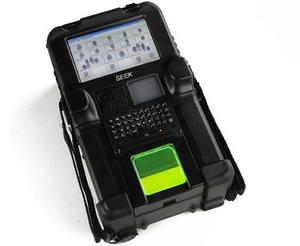Osama bin LadenCross Match's SEEK II may have identified bin Laden
SEEK II from Florida-based Cross Match is a 4-pound computer that captures photographs, complete fingerprints, and iris scans; its memory holds the images and biometrics of up to 60,000 people; unconfirmed reports suggest that the Navy SEALs who killed bin Laden used a SEEK II to identify him; there are about 5,000 SEEK II devices in the field, being used by the U.S. military, border patrol, and law enforcement agencies, and also by other militaries

The SEEK II combines three technologies in one unit // Source: crossmatch.com
It appears that the Navy SEALs who killed Osama bin Laden used a device from Palm Beach Gardens, Florida-based Cross Match to identify the al Qaeda’s founder, allowing President Obama to declare in his speech to the nation last week that bin laden was dead.
The Palm Beach Post reports that Cross Match representatives would not confirm whether their product was used in the identification of bin Laden, partly because they are not sure. Still, the Post says that company representatives “offer tantalizing hints, such as that the Department of Defense is one of their biggest clients and that their mobile device is the only one approved by the FBI to take rolled fingerprints, which provide more data and better matches than flat prints.”
The paper quotes Michael Oehler, vice president of mobile biometrics, to say that it appears that a Cross Match product was used to identify bin Laden “really is a good feeling, I must say. We have a very strong sense of patriotism in the company.”
The device likely used to identify bin Laden is the SEEK II — a 4-pound computer that captures photographs, complete fingerprints, and iris scans. Its memory holds the images and biometrics of “60,000 of your favorite bad guys,” Oehler said. With 3G technology or a satellite connection, the SEEK also can link to databases all over the world. This means that SEEK can identify a match within seconds – and helpful feature when the identification has to be doe under fire.
Oehler would not specify to the Post which data points the SEEK registers, but he said the technology generally measures things such as space between the eyes or the nostrils. It looks for features that do not degrade (measuring skin, which sags with age or can be transformed by plastic surgery, would not be useful).
Ohler noted that although an iris scan is 100 times more accurate than fingerprints, it is unlikely the military used the iris scan feature on bin Laden because that would require a previous iris scan to make a match. Moreover, even if bin Laden’s iris had been in the system, the SEALs would have had to move quickly to compare it with the real thing because an iris is “valid” for only five to ten minutes after death.
The company notes that there are fewer than 5,000 SEEKs currently in the field. The device is used by the U.S. military and other armies, and also by border patrol and other law enforcement agencies.
